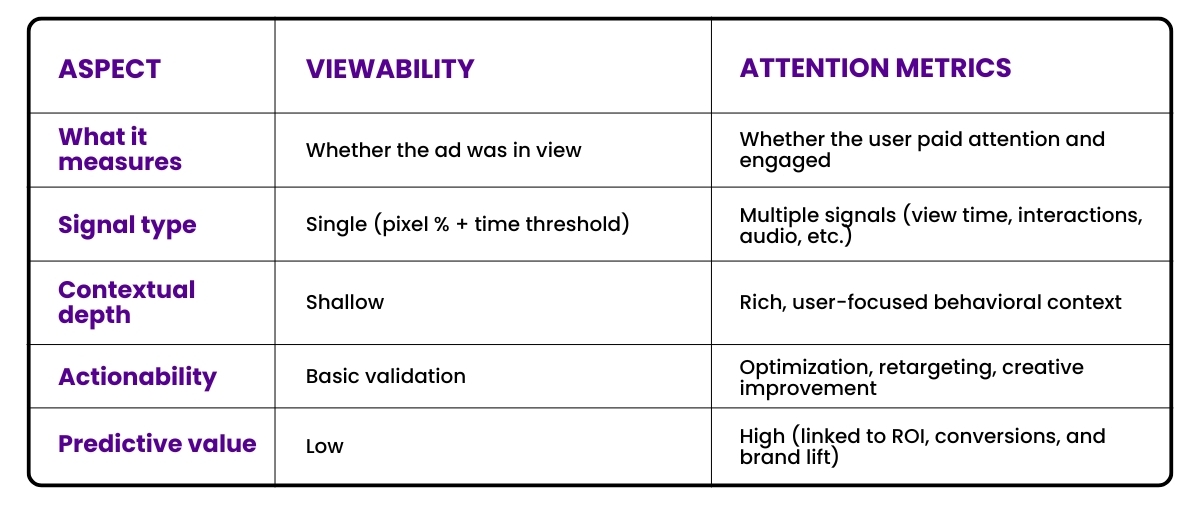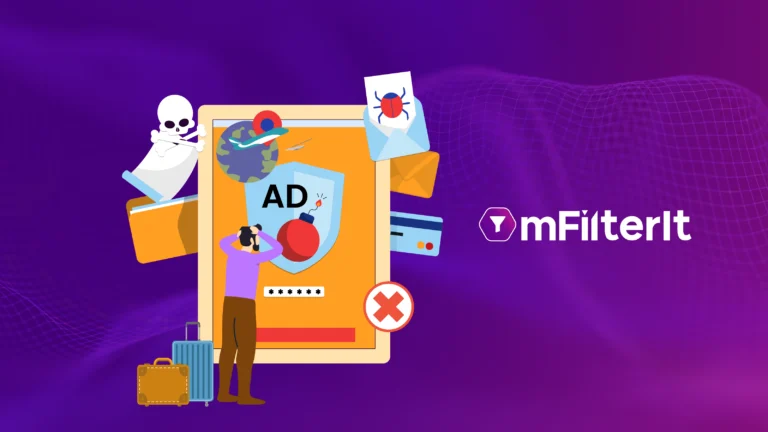Marketers have relied on viewability as a metric for the longest time to measure the success of an ad campaign. Afterall, an ad seen means the ad is working – right?
But with the auto-play video ads in the picture and the attention of the users moving to instant scrolling, the ad being just viewable cannot be reliable.
The hard truth that modern marketers are realizing – the ad might be technically “seen” but it can be completely being ignored by the audience.
Focusing just on viewability metrics is not sufficient to understand whether the user absorbed the ad’s message or not. Therefore, the need for an advanced ad metric to evaluate ad performance was required. This shifted the focus to attention measurement or what the industry now calls attention metrics.
In today’s ecosystem, where digital platforms are cluttered, user behavior is fragmented and choose what they really want to pay attention to, being seen is no longer enough. Brands need to understand the real difference between a wasted impression and a meaningful engagement.
In this blog, we’ll break down why viewability metrics are no longer enough, what attention metrics actually are, how they differ from traditional viewability, and how ad fraud detection solutions like Valid8 by mFilterIt are helping brands optimize not just for ad impressions, but for real impact.
Why Viewability Is No Longer Enough
For years, viewability has been the go-to metric to validate ad delivery. According to the IAB (Interactive Advertising Bureau) standard, an ad is considered “viewable” if 50% of its pixels are in view for at least one second (for display) or two seconds (for video).
Let’s take an example, think about a banner ad placed in the middle of where the page scroll ends. As per the IAB standard, if it is 50% visible, it will be considered viewed. But in reality, your ad failed to get the attention of your viewers. Or a muted video ad that autoplay’s in the background, technically viewed, but your user never saw it.
This is where improvement was really needed from older viewability standards, which didn’t account for whether the user ever saw the ad at all.
Viewability is a binary metric. It doesn’t reveal:
- Whether the user noticed the ad
- Whether it resonated
- Whether it drove engagement or action
What are Attention Metrics?
Attention metrics is a more advanced, holistic way to measure ad engagement. They go beyond visibility and ask: Did the ad actually capture the user’s attention?
Rather than relying on a single data point, attention metrics pull together a wide array of proxy measurement signals – behavioral, device context, user intent. Here’s how each signal helps reveal true engagement:
1. Time in View
An ad seen for 1 second isn’t equal to one seen for 7 seconds.
Example: If a user pauses scrolling and watches your ad for 8 seconds, it signals genuine interest, unlike someone who scrolls past instantly.
2. Scroll Depth
How far a user scrolls before encountering your ad can impact its effectiveness.
Example: If your display ad is placed lower on a webpage but still gets noticed, it reflects active user engagement, not passive viewability.
3. Position on Screen
Ads placed at the top of the page are more likely to be seen but not necessarily remembered.
Example: An ad shown at eye-level in the content zone is more likely to draw attention than one placed in the banner blind spot.
4. Audio Status (Mute vs. Unmute)
Muted ads play in the background. Unmuted ads demand attention.
Example: If a user unmutes a video, it’s a strong indicator they want to hear your message, far more valuable than just a view.
5. Pause/Play Behavior
This signal captures active intent to watch rather than passive exposure.
Example: If someone pauses your video mid-way and resumes later, they’re engaged. That’s meaningful attention; viewability cannot track that.
6. Skip Rate & Skip Point
In skippable ads, when users skip matters more than if they skip.
Example: If 80% of users skip at 3 seconds, your hook isn’t working. If most watch for 7-10+ seconds, you’ve captured their attention.
7. Screen Orientation
Device orientation changes reflect real-time distraction or focus.
Example: A user flipping their phone from portrait to landscape to watch your video indicates commitment. Switching apps mid-ad signals lost attention.
8. Click or Interaction Activity
Clicking, swiping, or engaging with ad elements shows active intent.
Example: Hovering over a CTA or clicking to expand a product carousel shows curiosity, an attention metric that impressions can’t quantify.
9. Dual-Screen Behavior
This detects whether users are actively watching your ad or multitasking on another screen or app.
Example: If a user switches to another app mid-ad (like messaging or social media), it signals attention drop-off, even if the ad was technically in view.
The Core Differences: Viewability vs Attention Metrics

Challenges Brands Face Without Attention Metrics
Viewability metrics create blind spots across different ad formats, ultimately affecting how brands measure, optimize, and scale their campaigns. Here how:
Display Ads
1. Lack of Depth in User Engagement – Without attention metrics, brands can’t differentiate between a view and actual user interest or interaction.
2. No Insight into On-Screen Placement Performance – Ads may be technically viewable but shown in low-engagement zones, leading to misjudged campaign effectiveness.
3. Inability to Identify and Prioritize High-Intent Ad Impressions – Without behavioral data like time-in-view or interaction rates, valuable signals for retargeting and optimization are lost.
4. Exposure to Display Ad Frauds like Ad Stacking – Without attention validation, fraudulent tactics such as ad stacking, where multiple ads are layered on top of one another, inflate viewability numbers while delivering zero real attention.
Skippable Video Ads
1. Misleading Viewability and Completion Metrics – Videos may be counted as viewed even when skipped early, hiding poor creative ad performance.
2. No Visibility into Drop-Off Trends – Without skip point tracking, brands cannot identify where audience interest fades or how to refine the first few seconds.
3. Missing Behavioral and Device-Level Signals – Important indicators like mute status or screen changes are untracked, leading to incomplete understanding of attention quality.
Non-Skippable Video Ads
1. Over-Reliance on Completion Rates – Assuming full attention just because the ad plays to the end overlooks passive or distracted viewing.
2. No Data on Real-Time Interaction – Without signals like pause/play, mute/unmute, and dual screen observation, there’s no visibility into how users respond during the ad.
3. Blind Spots in Device and Format Experience – Attention can vary significantly depending on screen size, orientation, and playback mode, but these factors remain unmeasured without deeper metrics.
Why This Shift Towards Attention Metrics Matters for Marketers
The transition from viewability to attention isn’t just a measurement metric upgrade, it’s a strategic necessity in 2025. Here’s why attention metrics matter:
1. Context is King
An ad watched with sound on, in a full-screen CTV environment, delivers exponentially more impact than one barely glanced at during a busy scroll. Attention metrics help decode where and how ads are most likely to land effectively.
2. Creative Optimization
By analyzing which creative elements correlate with high attention scores, marketers can learn which creative worked, why it worked, and optimize messaging, visuals, and sequencing accordingly. It’s not just about A/B testing, it’s about A/B learning
3. Media Planning Precision
Attention insights uncover top-performing platforms, publishers, formats, and time slots, as highly viewable environments enhance the likelihood of engaging and retaining audiences. This helps media campaign planners to plan for impact and not just ad impressions.
4. True ROI Measurement
By measuring attention score and quality exposure of each campaign, marketers can evolve from traditional CPM to a adCPM (attention-adjusted CPM). This ensures ad budget spend is aligned with genuine user engagement, not inflated visibility stats.
How mFilterIt Delivers Attention Metrics Intelligence That Matters
At mFilterIt, we go beyond viewability to offer a comprehensive, behavioral signal-rich attention measurement solution through our proprietary ad fraud detection, Valid8.
Unlike traditional metrics, Valid8 analyzes real engagement across both display and video ads, including skippable and non-skippable formats. It tracks critical signals like viewability, time in view, skip rates, mute/unmute status, screen orientation, interaction behaviors, and more to build a detailed attention profile.
These signals are processed by AI-powered Attention Score Algorithm, which categorizes ad impressions into High, Medium, or Low Intent based on various parameters mentioned above. This allows brands to not only measure true attention, but also optimize campaigns and build custom audience segments for smarter retargeting.
On the dashboard, advertisers gain access to deeper insights like quartile completion rates, engagement trends, device-based attention patterns, and format-specific ad performance metrics, helping them identify exactly where attention is earned and where it’s lost.
With Valid8, marketers can optimize creatives, refine targeting strategies, and ultimately shift their focus from impressions that were served to engagement that mattered.
Final Thought: Attention Metrics are the New Currency for Digital Advertising Ecosystem
In the noisy world of modern digital media, just being seen isn’t enough. Brands that want to drive real impact must evolve their measurement strategy, from viewability to true attention measurement.
Attention metrics are becoming the new industry standard for ad performance, personalization, and ROI optimization.
With Valid8 by mFilterIt, you don’t just know if your ad was viewed, you understand how it performed, who it resonated with, and where your next opportunity lies.
Ready to Move Beyond Viewability?
Let’s help you uncover what your metrics have been missing.




